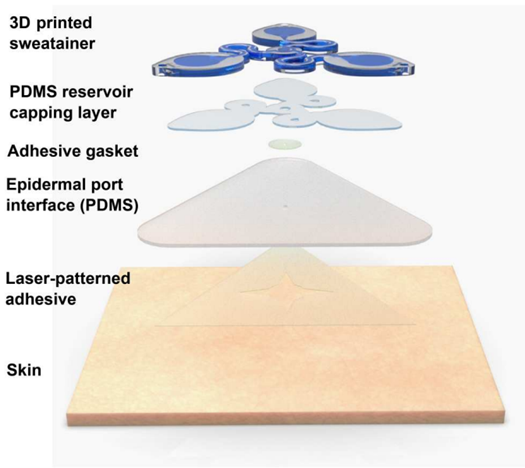Eccrine sweat is an attractive biofluid for analyte detection and non-invasive health monitoring as it contains many biomarkers relevant to physiological health. Monitoring of electrolytes, metabolites, hormones, proteins and other exogenous agents in sweat may offer time-dynamic insights into metabolomic processes for health, nutrition and wellness. Traditional approaches for collecting sweat, such as absorbent pads or tubes, require trained personnel and expensive equipment for analysis and as such are not amenable to real-time analyses.
Wearable biosensors allow for intermittent or continuous non-invasive detection of analytes found in eccrine sweat. Because wearable sensors can provide continued real-time sensing with a relatively small footprint, they are ideal for monitoring and/or managing diseases without the need for frequent physician visits and cumbersome equipment.
There is an emerging class of wearable biosensors, which integrate microfluidic lab-on-chip designs with low-modulus (flexible) materials to support real-time, non-invasive sweat analysis. While initial systems have been simple, current designs utilize sophisticated network channels, valves and reservoirs. Although these platforms have powerful analytical capabilities, their soft-lithography-based fabrication requires time, labor and resource-intensive cleanroom processing, which restricts the device design space and increases development time.
Technology
Dr. Tyler Ray, an assistant professor at the University of Hawai‘i, and his colleagues, have created a novel class of flexible, stretchable, epidermal microfluidic (epifluidic) wearable devices, utilizing micro digital light processing (µDLP) printers. This fabrication technique produces devices with monolithic channels, valves and patterned open reservoirs with complex architectures that have previously been unachievable. The device platform supports the use of capillary burst valves (CBVs) to enable time-sequential sweat collection. Benchtop and on-body testing have been performed to validate performance of the 3D-epifluidic devices.
These 3D-printed epifluidic devices and their methods of fabrication offer a transformative approach to the rapid prototyping of wearable sweat biosensors with true microfluidic dimensions. They reduce both fabrication time and cost and at the same time expand the design space for additional device architectures and capabilities.

Applications:
-
Real-time eccrine sweat analysis
-
Disease management and diagnostics
-
Personalized health/medical monitoring
-
Fitness tracking – sports, military, fire fighters
-
Advantages:
-
Reduction in prototype development cost and cycle time
-
Expands device capabilities with maximization of 3D design space
-
Enhanced optical transparency of 3D printed channels
-
Seamless, thin, skin-safe epidermal interface
-
Soft and flexible, but still a robust, water-tight interface between the device and epidermal port
-
-
Simple and rapid device replacement
-
Platform supports time-sequential sweat collection
-
Can be analyzed directly or sent to a lab
-
-
Enables collection of pristine sweat samples during an extended active period of time
Additional Information:
Inventor(s): Tyler Ray, UH; Chung-Han Wu, UH; Howin Ma, UH
Publication(s): Wu et al, Science Advances 2023; News Release 2023
IP: Published PCT Application WO 2023/049352 A1
Contact: Angel Stigen, Business Development Consultant, [email protected], 480.242.8844